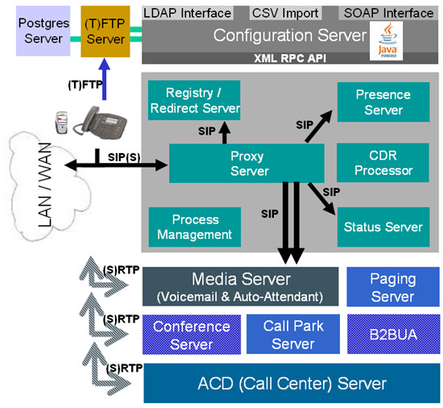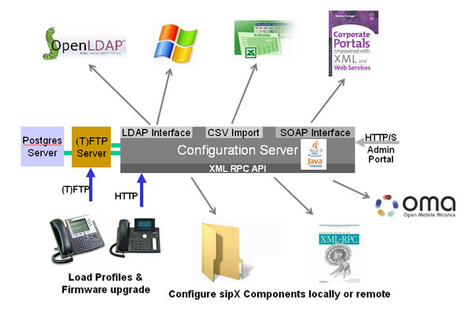The sipXecs System Architecture Diagram
The sipXecs system is built based on a modular architecture with different components that communicate over TCP/IP for the most part.
The SIP protocol was designed in support of a fully distributed architecture where different features are provided by servers that again communicate among themselves using the SIP protocol. There is a strict separation between Media and Signaling, which allows a globally scalable system to be built with the necessary redundancy and resiliency. Media streams, once setup, flow directly between end-points (phones and gateways) without any requirement for media to go through a central signaling server.
|
Highlights
|
|
|
Given its architecture, the sipXecs system is designed to interoperate with other third party feature servers. In addition, as we accomplished our objective of a truly distributed system, several instances of every component can be run on dedicated hardware and in different geographical locations to render a very scalable system. The sipXecs Configuration Server provides plug & play management for core components, all feature servers, as well as connected peripherals such as phones and gateways. An XML-based plug-in framework allows easy inclusion of additional components, both feature servers as well as additional peripherals. Documentation exists about how to add support for additional phones and [xecsuser:gateways].
While the different components of the sipXecs system could be used stand-alone, the focus of the project has been to provide a complete sipXecs IP PBX system out-of-the-box. On Fedora, Red Hat, Debian and Gentoo distributions, the sipXecs system can be installed easily using the distributions's respective package management system from our repository.
Architecture of the Configuration Server
The sipXecs Configuration Server is a Web Services based configuration management system that offers plug & play management for all the sipXecs server components including all connected phones and gateways. If connects to the existing IT infrastructure e.g. using LDAP and allows Web Services portals to use its services over a SOAP interface. It also allows integration with Microsoft Active Directory and Exchange 2007.
User data can be uploaded from LDAP or using a comma-delimited CSV
file typically generated by a spreadsheet application. We also started
work on integrating an OAM DM stack used to configure "over-the-air"
multiband cell phones that support SIP over WiFi.
The following library components are used
|
|
|

